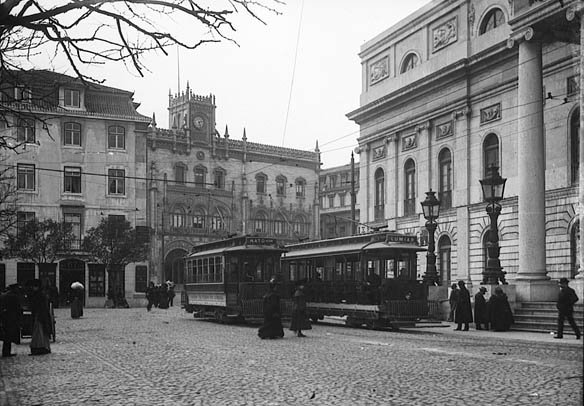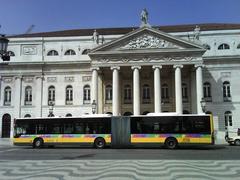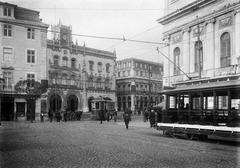
Teatro Nacional D. Maria II: Visiting Hours, Tickets, and History Guide – Lisbon, Portugal
Date: 14/06/2025
Introduction
Situated in the bustling Rossio Square at the heart of Lisbon, the Teatro Nacional D. Maria II (TNDM II) stands as a remarkable testament to Portugal’s rich artistic, historical, and architectural legacy. This neoclassical theatre, inaugurated in 1846, not only impresses with its majestic façade and grand interiors but also serves as a dynamic cultural institution. Currently undergoing a significant restoration, the theatre continues to engage audiences through performances across alternative venues, ensuring its enduring impact on Portugal’s cultural landscape (Wikipedia; PortugalVisitor.com).
This detailed guide provides an in-depth look at Teatro Nacional D. Maria II’s history, architecture, practical visitor information—including hours, ticketing, and accessibility—and highlights nearby attractions to help you make the most of your Lisbon visit.
Table of Contents
- Introduction
- Historical Overview
- Visiting Information
- Architectural Highlights
- Cultural and National Significance
- Frequently Asked Questions (FAQ)
- Key Dates and Figures
- Plan Your Visit
- Conclusion
- References
Historical Overview
Origins and Early Foundations
The site of Teatro Nacional D. Maria II has a layered past. Originally home to the Palácio dos Estaus (ca. 1450), the location evolved from hosting foreign dignitaries to serving as the seat of the Portuguese Inquisition in the 16th century—a period marked by persecution and public executions (LisbonLisboaPortugal.com). The palace survived the 1755 Lisbon earthquake but was ultimately destroyed by fire in 1836, clearing the way for the construction of the theatre (Wikipedia).
The Liberal Revolution and the Birth of a National Theatre
The Liberal Revolution of the early 19th century fostered an environment where the arts could flourish free from monarchical and ecclesiastical constraints. Almeida Garrett, a leading Romantic poet and dramatist, envisioned a national theatre that would embody Portuguese cultural identity. With royal support from Queen Maria II, plans for the new theatre were set in motion (PortugalVisitor.com).
Construction and Architectural Grandeur
Construction began in 1842, led by Italian architect Fortunato Lodi, whose neoclassical design drew inspiration from Palladian ideals. The theatre’s iconic façade features six Ionic columns salvaged from the destroyed Saint Francis Convent, symbolizing continuity and resilience (LisbonLisboaPortugal.com; Explorial). A statue of Gil Vicente, father of Portuguese drama, crowns the building, signifying the triumph of artistic expression over prior censorship. Inside, the Sala Garrett auditorium dazzles with a ceiling painting by José Maria Branco and a stage curtain depicting pre-1755 Lisbon (pt.wikipedia).
Fires, Restoration, and Modernization
A devastating fire in 1964 destroyed the interior, prompting over a decade of restoration that balanced historical fidelity with modern safety and comfort. The theatre reopened in 1978 and has since remained a pillar of Lisbon’s cultural scene (PortugalVisitor.com; LisbonLisboaPortugal.com). The current comprehensive restoration, begun in 2023, aims to modernize the building while preserving its national monument status, with reopening expected in early 2026 (Sábado).
Visiting Information
Visiting Hours
- As of 2024: The historic theatre is closed for restoration until early 2026. Performances continue at alternative venues across Lisbon.
- Normal Hours (upon reopening): Typically, the theatre is open Tuesday to Sunday, 11:00 AM–6:00 PM. Guided tours are often available on Mondays at 11:00 AM (Neighbourly Lisbon).
- Box Office: Usually open from 1:00 PM–7:00 PM on performance days and 1:00 PM–6:00 PM on non-performance days.
For the most up-to-date hours, visit the official website.
Tickets and Booking
- Ticket Purchases: Available online via the official website, at box offices of temporary venues, or through authorized platforms (TNDM II Tickets).
- Prices: Generally range from €10–€40, varying by production and seating category.
- Discounts: Offered for students, seniors, groups, and families on select performances.
- Advance Booking: Highly recommended, especially for popular shows and guided tours.
Accessibility
- Physical Access: Upon reopening, the theatre will feature improved accessibility with ramps, elevators, and adapted seating.
- Temporary Venues: Also provide wheelchair access and accommodations for visitors with disabilities.
- Assistance: Contact the theatre in advance for specific needs (TNDM II Accessibility).
Guided Tours and Educational Programs
- Guided Tours: Explore neoclassical architecture, backstage areas, and historical anecdotes. Primarily available on weekends or Mondays, booking in advance is advised.
- Educational Programs: Include workshops, youth outreach, and thematic cycles celebrating Portuguese heritage.
Nearby Attractions
- Rossio Square: Lively plaza with wave-patterned pavement and ornamental fountains.
- Santa Justa Lift: Neo-Gothic elevator with panoramic city views (Santa Justa Lift).
- Carmo Convent: Atmospheric medieval convent ruins and archaeological museum (Carmo Convent).
- Chiado District: Lisbon’s arts and shopping quarter, ideal for strolling and café culture.
- National Theatre Museum: A short ride away for enthusiasts of theatre history (National Theatre Museum).
Architectural Highlights
- Neoclassical Façade: Six Ionic columns from the Saint Francis Convent, triangular pediment with Apollo and the Muses relief.
- Statue of Gil Vicente: Symbolizing the reclamation of artistic freedom.
- Sala Garrett: Main auditorium seating approximately 900, with lavish ceiling artwork and a historic stage curtain (pt.wikipedia).
- Studio Theatre: Modern, flexible performance space for contemporary works (Kuiper Lisbon).
- Integration with Rossio Square: The theatre acts as an architectural anchor in Lisbon’s urban fabric (Travel in Portugal).
Cultural and National Significance
Teatro Nacional D. Maria II is more than a historic building; it is a living institution representing Portugal’s journey from absolutism to liberalism, from censorship to artistic flourishing. Its repertoire spans classical works by Gil Vicente and Luís de Camões to contemporary productions that address current social themes. The theatre’s archival library is a crucial resource for researchers, preserving centuries of Portuguese theatrical history (PortugalVisitor.com).
During the current restoration, initiatives like the “Odisseia Nacional” bring performances and workshops to dozens of municipalities nationwide, ensuring cultural democratization and sustained community impact (Público). Annual thematic cycles, such as those commemorating the Carnation Revolution, reinforce the theatre’s civic mission (Time Out Lisboa).
Frequently Asked Questions (FAQ)
Q: When will Teatro Nacional D. Maria II reopen?
A: The theatre is expected to reopen in early 2026 after extensive renovations.
Q: How can I attend performances during the closure?
A: Performances are held at alternative venues. Tickets and information are available via the official website and box offices.
Q: Is the theatre accessible to visitors with disabilities?
A: Yes, both the main theatre (upon reopening) and temporary venues offer accessible facilities.
Q: Are guided tours available?
A: Guided tours will resume upon reopening. Advance booking is recommended.
Q: What are some nearby attractions?
A: Rossio Square, Santa Justa Lift, Chiado, Carmo Convent, and the National Theatre Museum are all close by.
Q: Are performances in English or with subtitles?
A: Most shows are in Portuguese, but select productions offer English surtitles or summaries (TNDM II Programme).
Key Dates and Figures
- 1450: Palácio dos Estaus constructed.
- 16th century: Palace becomes seat of the Portuguese Inquisition.
- 1755: Palace survives the Lisbon earthquake.
- 1836: Palace destroyed by fire.
- 1842–1846: Construction of Teatro Nacional D. Maria II.
- 13 April 1846: Official inauguration.
- 1964: Catastrophic fire.
- 1978: Reopening after restoration.
- 2023–2026: Comprehensive restoration and modernization (Sábado).
Plan Your Visit
- Stay Updated: For the latest on reopening, ticket sales, and programming, visit teatro.maria2.pt.
- Download the Audiala App: Receive real-time updates, ticket offers, and exclusive behind-the-scenes content.
- Explore More: Combine your theatre visit with tours of Lisbon’s historical core, including Baixa and Chiado districts.
Conclusion
Teatro Nacional D. Maria II embodies the spirit of Lisbon—resilient, innovative, and deeply connected to its past. Whether attending an avant-garde production at a temporary venue or planning a future visit to its grand Rossio home, the theatre offers a gateway to Portuguese culture, history, and artistry. Stay tuned for its anticipated reopening and immerse yourself in the legacy of this national treasure.
References
- D. Maria II National Theatre, Wikipedia, 2024
- Visiting Teatro Nacional D. Maria II, LisbonLisboaPortugal.com, 2024
- Teatro Nacional D. Maria II Overview, PortugalVisitor.com, 2024
- Teatro Nacional D. Maria II Restoration and Programming, Sábado, 2024
- Teatro Nacional D. Maria II Cultural Initiatives, Público, 2024
- Teatro Nacional D. Maria II Visitor Guide, Travel in Portugal, 2024
- Teatro Nacional D. Maria II Cultural Significance, Time Out Lisboa, 2024
- Neighbourly Lisbon
- Kuiper Lisbon
- TNDM II Tickets
- TNDM II Accessibility
- TNDM II Programme
- Santa Justa Lift
- Carmo Convent
- National Theatre Museum




























































